Cetartiodactyla
Les Cétartiodactyles (Cetartiodactyla) forment un ordre (ou, selon d'autres sources, un clade non classé) de mammifères ongulés, dont la principale caractéristique est de posséder un nombre pair de doigts (2 ou 4), contrairement aux Périssodactyles.
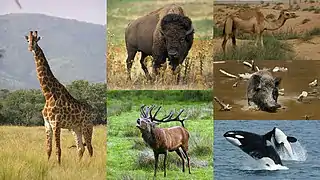
| Règne | Animalia |
|---|---|
| Embranchement | Chordata |
| Sous-embr. | Vertebrata |
| Super-classe | Tetrapoda |
| Classe | Mammalia |
| Cohorte | Placentalia |
| Super-ordre | Laurasiatheria |
Caractéristiques
Dans ce groupe, l'axe des membres postérieurs passe entre les doigts III et IV (cette disposition est appelée paraxonie). Ce clade regroupe les Tylopodes, les Suines, les Ruminants, les Hippopotamidés et les Cétacés. Plus précisément, ce clade est la fusion des deux anciens ordres Cetacea et Artiodactyla. La parenté (proximité au sens phylogénétique) de ces différents groupes, qui rassemblent des animaux morphologiquement très différents, est fondée à la fois sur des caractères évolués communs (synapomorphies) et sur des études génétiques[1].
Ce taxon est, selon les auteurs, un ordre[2],[3] (s'il remplace les ordres Cetacea et Artiodactyla) ou un clade non classé[4]. Il est parfois considéré comme un super-ordre[5] (s'il est placé au-dessus des ordres Cetacea et Artiodactyla), bien que l'arbre phylogénétique montré ci-dessous infirme cette hypothèse. En effet, il montre que le groupe « Artiodactyla » serait paraphylétique, car celui-ci, excluant les Cetacea, regrouperait des animaux plus proches génétiquement de ces derniers (tels que l'hippopotame) que des autres Artiodactyla.
On compte actuellement 332 espèces reconnues de cétardiodactyles, réparties dans 132 genres et 22 familles[6].
Description

- Un système digestif avec deux ou trois pré-estomacs
- Le talus ou astragale de la cheville est à double poulie, avec une poulie tibiale proximale et une poulie naviculaire distale.[7]
- L'astragale est en contact avec l'os cuboïde[7].
- Des membres paraxoniques, c'est-à-dire que l'axe fonctionnel du membre est parallèle et déplacé vers l’extérieur par rapport à l'axe théorique du troisième doigt[8]
- Trois bronches[8]
- Grandes glandes lacrymales[8]
- Longue crus breve incudis[8]
- Le muscle lisse à base de l'érection du pénis[8]
Classification
Selon Groves & Grubb, 2011[9] :
- Subordre Tylopoda
- Famille †Anoplotheriidae?
- Famille †Cainotheriidae
- Famille †Merycoidodontidae
- Famille †Agriochoeridae
- Famille Camelidae : chameaux et lamas (7 espèces actuelles et 13 éteintes)
- Famille †Oromerycidae
- Famille †Xiphodontidae
- Clade Artiofabula
- Subordre Suina
- Famille Suidae : phacochères, sangliers et porcs (19 espèces)
- Famille Tayassuidae : pécaris (4 espèces)
- Famille †Sanitheriidae
- Clade Cetruminantia
- Clade Cetancodontamorpha[10]
- Genre †Andrewsarchus?
- Famille †Entelodontidae
- Sous-ordre Whippomorpha
- Super-famille Dichobunoidea – paraphylétique des Cetacea et Raoellidae
- Famille †Dichobunidae
- Famille †Helohyidae
- Famille †Choeropotamidae
- Famille †Cebochoeridae
- Famille †Mixtotheriidae
- Infra-ordre Cetacea : cétacés (environ 90 espèces)
- Micro-ordre †Archaeoceti
- Famille †Pakicetidae
- Famille †Ambulocetidae
- Famille †Remingtonocetidae
- Famille †Basilosauridae
- Micro-ordre Mysticeti : baleines à fanons
- Super-famille Balaenoidea : baleines franches
- Famille Balaenidae (4 espèces)
- Famille Cetotheriidae (1 espèce)
- Super-famille Balaenopteroidea
- Famille Balaenopteridae (8 espèces)
- Famille Eschrichtiidae : baleine grise (1 espèce)
- Super-famille Balaenoidea : baleines franches
- Micro-ordre Odontoceti : baleine à dents
- Super-famille Delphinoidea : Dauphins (au sens large)
- Famille Delphinidae : Dauphins (38 espèces)
- Famille Monodontidae : baleines arctiques (2 espèces)
- Famille Phocoenidae : Marsouins (6 espèces)
- Super-famille Physeteroidea : cachalots (au sens large)
- Famille Kogiidae : (2 espèces)
- Famille Physeteridae : cachalot (1 espèces)
- Super-famille Platanistoidea : dauphins de rivière
- Famille Iniidae (2 espèces)
- Famille Lipotidae (dauphin de rivière chinois, peut-être éteint)
- Famille Platanistidae (dauphin de rivière d'Asie du sud)
- Famille Pontoporiidae (Dauphin de La Plata)
- Super-famille Ziphioidea
- Famille Ziphiidae : baleines à bec (22 espèces)
- Super-famille Delphinoidea : Dauphins (au sens large)
- Micro-ordre †Archaeoceti
- Famille †Raoellidae
- Infra-ordre Ancodonta
- Famille †Anthracotheriidae – paraphylétique aux Hippopotamidae
- Famille Hippopotamidae: hippopotames (2 espèces)
- Super-famille Dichobunoidea – paraphylétique des Cetacea et Raoellidae
- Clade Ruminantiamorpha
- Sous-ordre Ruminantia
- Infra-ordre Tragulina
- Famille †Amphimerycidae
- Famille †Prodremotheriidae
- Famille †Protoceratidae
- Famille †Hypertragulidae
- Famille †Praetragulidae
- Famille Tragulidae: chevrotains (six espèces)
- Famille †Archaeomerycidae
- Famille †Lophiomerycidae
- Infra-ordre Pecora
- Famille †Gelocidae
- Famille †Palaeomerycidae
- Famille Antilocapridae (1 espèce)
- Famille †Climacoceratidae
- Famille Giraffidae: okapi et 4 espèces de girafes
- Famille †Hoplitomerycidae
- Famille Cervidae (49 espèces)
- Famille †Leptomerycidae
- Famille Moschidae (7 espèces)
- Famille Bovidae: bovins, antilopes et autres (135 espèces)
- Infra-ordre Tragulina
- Sous-ordre Ruminantia
- Clade Cetancodontamorpha[10]
- Subordre Suina

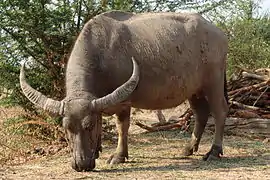

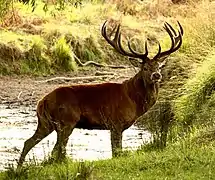

%252C_parque_nacional_de_Chobe%252C_Botsuana%252C_2018-07-28%252C_DD_82.jpg.webp)

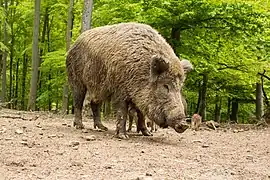

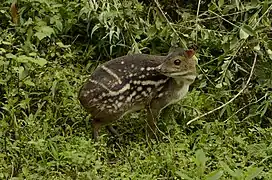 Moschiola indica (Tragulidae)
Moschiola indica (Tragulidae)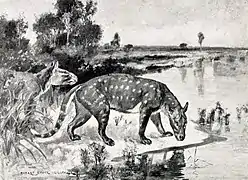 Reconstitution de Agriochoerus (Agriochoeridae)
Reconstitution de Agriochoerus (Agriochoeridae)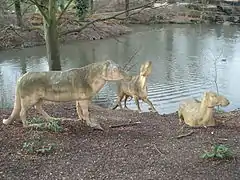 Reconstitution de Anoplotherium (Anoplotheriidae)
Reconstitution de Anoplotherium (Anoplotheriidae)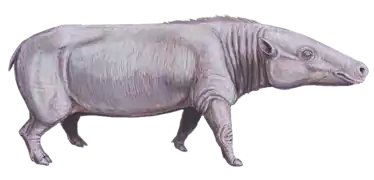 Reconstitution de Anthracotherium (Anthracotheriidae)
Reconstitution de Anthracotherium (Anthracotheriidae)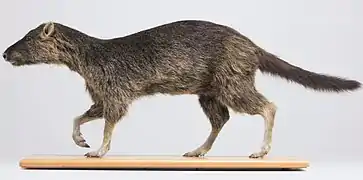 Reconstitution de Amphirhagatherium weigelti (Choeropotamidae)
Reconstitution de Amphirhagatherium weigelti (Choeropotamidae)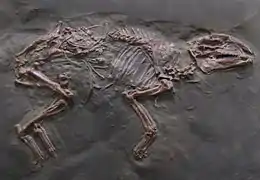 Fossile de Messelobunodon schaeferi (Dichobunidae)
Fossile de Messelobunodon schaeferi (Dichobunidae) Reconstitution de Daeodon shoshonensis (Entelodontidae)
Reconstitution de Daeodon shoshonensis (Entelodontidae)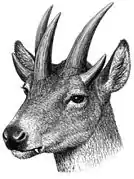 Reconstitution de Hoplitomeryx (Hoplitomerycidae)
Reconstitution de Hoplitomeryx (Hoplitomerycidae)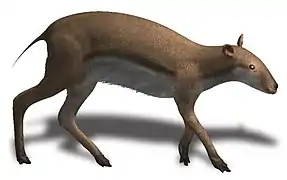 Reconstitution de Leptomeryx (Hypertragulidae)
Reconstitution de Leptomeryx (Hypertragulidae)_(17528024554).jpg.webp) Reconstitution de Merycoidodon bullatus (Merycoidodontidae)
Reconstitution de Merycoidodon bullatus (Merycoidodontidae)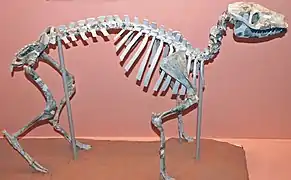 Fossile de Eotylopus reedi (Oromerycidae)
Fossile de Eotylopus reedi (Oromerycidae) Reconstitution de Ampelomeryx ginsburgi (Palaeomerycidae)
Reconstitution de Ampelomeryx ginsburgi (Palaeomerycidae).jpg.webp) Reconstitution de Syndyoceras (Protoceratidae)
Reconstitution de Syndyoceras (Protoceratidae) Reconstitution de Indohyus (Raoellidae)
Reconstitution de Indohyus (Raoellidae)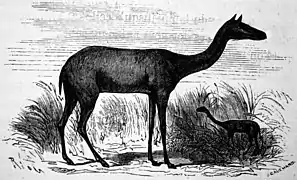 Reconstitution de Xiphodon (Xiphodontidae)
Reconstitution de Xiphodon (Xiphodontidae)
Phylogénie interne
Phylogénie des familles des Cétartiodactyles actuels (Cétacés non développés), d'après Price et al., 2005[11] et Spaulding et al., 2009[12]:
| Cetartiodactyla |
| |||||||||||||||||||||||||||||||||||||||||||||||||||||||||||||||
La place des Cétacés au sein des Artiodactyles et à proximité des Hippopotames est un produit récent de la phylogénie moléculaire, confirmée depuis par des découvertes de fossiles. Les parentés des grands groupes et des familles, éteintes et actuelles, indiquées sur le cladogramme ci-dessus, suivent Geisler et al. 2007.
▲ └─o Cetartiodactyla ├─o │ ├─o Choeropotamidae (éteint) │ └─o Dichobunidae (éteint) │ ├─o Dichobuninae (éteint) │ ├─o Hyperdichobuninae (éteint) │ ├─o Eurodexeinae (éteint) │ └─o Lantianiinae (éteint) └─o ├─o │ ├─o Gujaratia (éteint) │ └─o │ ├─o Diacodexeidae (éteint) │ ├─o Helohyus (éteint) │ └─o Leptochoeridae (éteint) └─o ├─o Antiacodontidae (éteint) ├─o Tylopoda │ ├─o │ │ ├─o Homacodontidae (éteint) │ │ └─o Gobiohyus (éteint) │ └─o │ ├─o Bunomerycidae (éteint) │ └─o │ ├─o Anoplotheroidea (éteint) │ │ ├─o Dacrytheriidae (éteint) │ │ ├─o Cainotheriidae (éteint) │ │ │ ├─o Oxacroninae (éteint) │ │ │ └─o Cainotheriinae (éteint) │ │ └─o Anoplotheriidae (éteint) │ │ ├─o Robiaciinae (éteint) │ │ └─o Anoplotheriinae (éteint) │ └─o Cameloidea │ ├─o Eotylopus (éteint) │ └─o Camelidae │ ├─? Miotylopus (éteint) │ └─o │ ├─o Poebrodontinae (éteint) │ └─o │ ├─o Poebrotheriinae (éteint) │ └─o │ ├─o Pseudolabinae (éteint) │ └─o │ ├─o Camelinae │ │ ├─o Protolabidini (éteint) │ │ └─o │ │ ├─o Lamini │ │ └─o Camelini │ └─o │ ├─o Aepycamelinae (éteint) │ └─o │ ├─o Miolabinae (éteint) │ └─o │ ├─o Stenomylinae (éteint) │ └─o Floridatragulinae (éteint) ├─o Suiformes │ ├─o Entelodontidae (éteint) │ └─o Suoidea │ ├─o Sanitheriidae (éteint) │ └─o │ ├─o Huaxiachoerus (éteint) │ ├─o Egatochoerus (éteint) │ └─o │ ├─o Siamochoerus (éteint) │ └─o │ ├─o Odoichoerus (éteint) │ └─o │ ├─o Tayassuidae │ │ ├─o Doliochoerinae (éteint) │ │ └─o Tayassuinae │ └─o Suidae │ ├─o Eocenchoerus (éteint) │ └─o │ ├─o │ │ ├─o Taucanamo (éteint) │ │ └─o │ │ ├─o Yunnanochoerus (éteint) │ │ └─o Schizochoerini (éteint) │ └─o │ ├─o Palaeochoerus (éteint) │ └─o │ ├─o Hemichoerus (éteint) │ ├─o Paradoxodonides (éteint) │ ├─o Cainochoerus (éteint) │ └─o │ ├─o Hyotheriinae (éteint) │ └─o │ ├─o │ │ ├─o Listriodontinae (éteint) │ │ └─o Kubanochoerinae (éteint) │ └─o │ ├─o Miochoerus (éteint) │ └─o │ ├─o Tetraconodontinae (éteint) │ └─o │ ├─o Namachoerinae │ └─o Suinae │ ├─o Suini │ └─o │ ├─o Potamochoerini │ └─o │ ├─o Hippohyini (éteint) │ └─o │ ├─o Babyrousini │ └─o Phacochoerini └─o Cetruminantia ├─o Cetancodonta │ ├─o Raoellidae (éteint) │ └─o │ ├─o Cebochoeridae (éteint) │ └─o │ ├─o Cetacea ► │ └─o │ ├─o Mixtotheriidae (éteint) │ └─o Anthracotheriidae (éteint) (paraphylétique) │ ├─o Siamotherium (éteint) │ ├─o Anthracohyus (éteint) │ └─o │ ├─o Anthracotheriinae (éteint) │ └─o │ ├─o Microbunodontinae (éteint) │ └─o Bothriodontinae (éteint) (paraphylétique) │ └─o Hippopotamidae │ ├─o Kenyapotaminae (éteint) │ └─o Hippopotaminae └─o ├─o Amphirhagatherium (éteint) └─o ├─o │ ├─o │ │ ├─o Agriochoeridae (éteint) │ │ └─o Leptotragulinae (éteint) │ └─o │ ├─o Xiphodontoidea (éteint) │ │ ├─o Amphimerycidae (éteint) │ │ └─o Xiphodontidae (éteint) │ └─o │ ├─o Leptoreodon (éteint) │ └─o Oreodontidae ou Merycoidodontidae (éteint) │ ├─o Oreonetinae (éteint) │ └─o │ ├─o Leptaucheniinae (éteint) │ │ ├─o Leptaucheniini (éteint) │ │ └─o Sespiini (éteint) │ └─o │ ├─o Oreodontinae (éteint) │ └─o │ ├─o Miniochoerinae (éteint) │ └─o │ ├─o Desmatochoerinae (éteint) │ └─o │ ├─o Promerycochoerinae (éteint) │ └─o │ ├─o Merychyinae (éteint) │ └─o │ ├─o Eporeodontinae (éteint) │ └─o │ ├─o Phenacocoelinae (éteint) │ └─o │ ├─o Ticholeptinae (éteint) │ └─o Merycochoerinae (éteint) └─o ├─o Protylopus (éteint) └─o ├─o Protoceratidae (éteint) │ ├─o Heteromeryx (éteint) │ └─o │ ├─o Protoceratinae (éteint) │ └─o Synthetoceratinae (éteint) │ ├─o Synthetoceratini (éteint) │ └─o Kyptoceratini (éteint) └─o Ruminantia ├─o Indomeryx (éteint) ├─o Hypertragulidae (éteint) ├─o Praetragulidae (éteint) └─o ├─o Tragulidae └─o ├─o Bachitheriidae (éteint) └─o ├─o Leptomerycidae (éteint) ├─? Archaeomerycidae (éteint) └─o ├─o Lophiomerycidae (éteint) └─o Pecora ├─o Gelocus (éteint) └─o ├─? Notomeryx (éteint) └─o ├─o Prodromotherium (éteint) └─o ├─? Rutitherium (éteint) ├─o Giraffoidea │ ├─o Climacoceratidae (éteint) │ └─o Giraffidae │ ├─o Sivatheriinae (éteint) │ └─o Giraffinae │ ├─o Giraffini │ └─o Palaeotragini │ ├─o Paleotragina (éteint) │ └─o Okapiina ├─o Antilocapridae │ ├─? Merycodontinae (éteint) │ └─o Antilocaprinae │ ├─o Proantilocapra (éteint) │ └─o │ ├─o Ilingoceratini (éteint) │ └─o │ ├─o Antilocaprini │ └─o Stockoceratini (éteint) └─o ├─o │ ├─? Walangania (éteint) │ └─o │ ├─o Moschidae │ │ ├─o Dremotheriinae (éteint) │ │ └─o │ │ ├─o Blastomerycinae (éteint) │ │ └─o Moschinae │ └─o │ ├─o Palaeomerycidae (éteint) │ │ ├─o Palaeomerycinae (éteint) │ │ └─o │ │ ├─o Aletomerycinae (éteint) │ │ └─o Dromomerycinae (éteint) │ │ ├─o Dromomerycini (éteint) │ │ └─o Cranioceratini (éteint) │ └─o │ ├─o Hoplitomerycidae (éteint) │ └─o Cervidae │ ├─o Hydropotinae │ └─o │ ├─o Muntiacinae │ │ ├─o Lagomerycini (éteint) │ │ └─o │ │ ├─o Dicrocerini (éteint) │ │ └─o Muntiacini │ └─o │ ├─o Odocoilinae ou Capreolinae │ │ ├─o Capreolini │ │ └─o │ │ ├─o Odocoileini │ │ └─o Alceini │ └─o Cervinae │ ├─o Pliocervini (éteint) │ └─o │ ├─o Megacerini (éteint) │ └─o Cervini └─o Bovidae ├─o Boodontia ou Bovinae │ ├─o Boselaphini │ └─o │ ├─o │ │ ├─o Udabnocerini (éteint) │ │ └─o Tragelaphini │ └─o Bovini │ ├─o Bubalina │ └─o │ ├─o Pseudorygina │ └─o Bovina └─o Aegodontia ├─o Aepycerotinae └─o ├─o Cephalophinae │ ├─o Cephalophini │ └─o Reduncini └─o ├─o Antilopinae └─o ├─o │ ├─o Hippotraginae │ │ ├─o Orygina │ │ └─o Hippotragina │ └─o Alcelaphinae │ ├─o Connochaetina │ └─o Alcelaphina └─o Caprinae ├─o Pantholopini └─o ├─o Caprini │ ├─o Ovina │ └─o Caprina └─o ├─o Ovibovini └─o Naemorhedini
Galerie
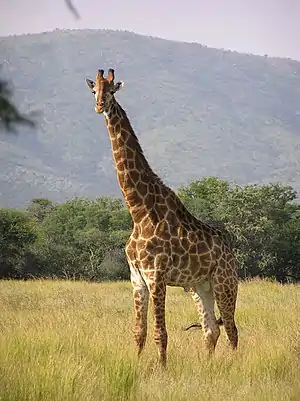 Girafe (Giraffa camelopardalis, Giraffidae)
Girafe (Giraffa camelopardalis, Giraffidae) Chameau (Camelus bactrianus, Camelidae)
Chameau (Camelus bactrianus, Camelidae) Oryx gazelle (Oryx gazella, Bovidae)
Oryx gazelle (Oryx gazella, Bovidae) Cerf de Virginie (Odocoileus virginianus, Cervidae)
Cerf de Virginie (Odocoileus virginianus, Cervidae) Bison d'Amérique (Bison bison, Bovidae)
Bison d'Amérique (Bison bison, Bovidae) Vache domestique (Bos taurus, Bovidae)
Vache domestique (Bos taurus, Bovidae) Sanglier d'Europe (Sus scrofa, Suidae)
Sanglier d'Europe (Sus scrofa, Suidae)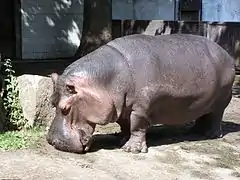 Hippopotame (Hippopotamus amphibius, Hippopotamidae)
Hippopotame (Hippopotamus amphibius, Hippopotamidae)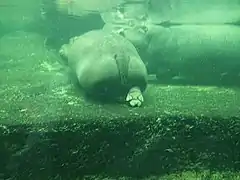 Vue sous l'eau des 4 doigts de la patte arrière d'un hippopotame signant son appartenance aux Artiodactyles.
Vue sous l'eau des 4 doigts de la patte arrière d'un hippopotame signant son appartenance aux Artiodactyles.
Sources bibliographiques de référence
- Jonathan H. Geisler, Jessica M. Theodor, Mark D. Uhen et Scott E. Foss : « Phylogenetic Relationships of Cetaceans to Terrestrial Artiodactyls », in The Evolution of Artiodactyls (Donald R. Prothero et Scott E. Foss éds.), JHU Press, p. 19-31, 2007, (ISBN 0801887356)
- Jean-Renaud Boisserie, Fabrice Lihoreau et Michel Brunet : « The position of Hippopotamidae within Cetartiodactyla », PNAS, vol. 102, no 5, p. 1537-1541, 2005
- J.H. Geisler et M. D. Uhen : « Morphological support for a close relationship between hippos and whales », Journal of Vertebrate Paleontology, vol. 23, p. 991-996, 2003
- Claudine Montgelard, François M. Catzelfis et Emmanuel Douzery : « Phylogenetic Relationships of Artiodactyls and Cetaceans as Deduced from the Comparison of Cytochrome b and 12s rRNA Mitochondrial Sequences », Molecular Biology and Evolution'', vol. 14, p. 550-559, 1997
Voir aussi
Articles connexes
Liens externes
- (en) Référence Paleobiology Database : Cetartiodactyla Montgelard et al. 1997
- (en) Référence Animal Diversity Web : Cetartiodactyla
- (en) Référence NCBI : Cetartiodactyla (taxons inclus)
Notes et références
- (en) C. Montgelard, F.M. Catzeflis et E. Douzery, « Phylogenetic Relationships of Artiodactyls and Cetaceans as Deduced from the Comparison of Cytochrome b and 12s rRNA Mitochondrial Sequences », Mol. Biol. Evol., vol. 14, no 5, , p. 550-559.
- Explore the Ungulate Family Tree
- « Cetartiodactyla », sur www.manimalworld.net (consulté le )
- « Lifemap », sur lifemap.univ-lyon1.fr (consulté le )
- (en) Référence Animal Diversity Web : Cetartiodactyla
- (en) A. Hassanin, F. Delsuc, A. Ropiquet, C. Hammer, B. Jansen van Vuuren, C. Matthee, M. Ruiz-Garcia, F. Catzeflis, V. Areskoug, TT. Nguyen et A. Couloux, « Pattern and timing of diversification of Cetartiodactyla (Mammalia, Laurasiatheria), as revealed by a comprehensive analysis of mitochondrial genomes. », Comptes rendus de l'Académie des sciences. Biologies, vol. Janvier 2012, no 335(1), , p. 32-50 (lire en ligne, consulté le ).
- Lecointre, Guillaume, (1964- ...), Visset, Dominique., Bosquet, Gilles. et Charrier, David., Classification phylogénétique du vivant. Tome 2 (ISBN 978-2-410-00385-7 et 2-410-00385-0, OCLC 987914329, lire en ligne), p. 551
- (en) Référence Animal Diversity Web : Cetacea
- (en) Colin P. Groves et Peter Grubb, Ungulate Taxonomy, Baltimore, Maryland, Johns Hopkins University Press, , 317 p. (ISBN 978-1-4214-0093-8), p. 25
- « A 'consensus cladogram' for artiodactyls », Tetrapod Zoology (consulté le )
- (en) Price SA, Bininda-Emonds OR, Gittleman JL, « A complete phylogeny of the whales, dolphins and even-toed hoofed mammals (Cetartiodactyla) », Biol Rev Camb Philos Soc., vol. 80, no 3, , p. 445-473 (DOI 10.1017/S1464793105006743, lire en ligne)
- (en) M Spaulding, MA O'Leary et J Gatesy, « Relationships of Cetacea (Artiodactyla) Among Mammals: Increased Taxon Sampling Alters Interpretations of Key Fossils and Character Evolution », PLoS ONE, vol. 4, no 9, , e7062 (PMID 19774069, PMCID 2740860, DOI 10.1371/journal.pone.0007062, Bibcode 2009PLoSO...4.7062S)
- Portail des mammifères